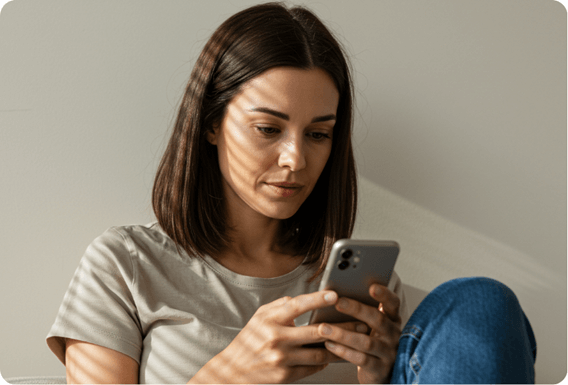Table of Contents
No doubt breathwork or deep breathing is good for you whether it’s through a yoga app, a meditation challenge, or a 30-second Instagram Reel, the message is clear: Just breathe—and you’ll feel better.
But here’s a truth we don’t talk about enough: for many people, especially women, breathwork can actually make anxiety worse.
If you’ve ever tried a breathing exercise and ended up feeling dizzy, more panicked, or disconnected from your body, you’re not alone—and you’re definitely not doing it wrong.
At Seesaw Health, we understand the science behind why this happens. More importantly, we’ve created a new kind of breathwork experience, one that is interactive, data-driven, and tailored to your pace, not perfection.
Let’s explore why deep breathing practice can backfire, and how Seesaw can help it actually work for you.
When Breathwork Backfires: 4 Reasons You Might Feel Worse
Despite its proven reputation as a universal stress reliever, breathwork can sometimes trigger anxiety when it’s done in the wrong way or without enough support.
Here’s why it may provoke anxiety:
1. Hyper-awareness of Bodily Sensations
People with anxiety, especially those prone to panic attacks, are often already highly attuned to their internal state. Being told to “focus on your breath” might seem innocent, but for some, it can amplify the sensations they fear most: a racing heart, shortness of breath, or chest tightness.
This kind of hypervigilance can turn deep breathing into a trigger instead of a relief.
2. Over-breathing and Dizziness
Many trending breathwork techniques on social media involve rapid or deep breathing (think box breathing, or 4-7-8 breath). These can unintentionally mimic the physiological symptoms of anxiety, such as tingling, dizziness, or lightheadedness, particularly if your nervous system is already on high alert.
In short, you may be breathing too much or too deeply for what your body actually needs.
3. Perfectionism and Performance Pressure
Mindfulness, like everything else in the digital age, can start to feel like a performance. If your mind drifts during a deep breathing session (which it will if you are not channeled), you might spiral into thoughts like: “Why can’t I even do this right?”
This self-criticism can hijack the calming intention of deep breathing and replace it with shame and pressure.
4. Lack of Real-Time Guidance
Most apps and YouTube videos offer one-size-fits-all practices. They don’t adjust based on your emotional state, your breathing rate, or how you’re responding in the moment. This lack of responsiveness can leave you feeling disconnected, unregulated, or even more dysregulated than before you started.
So, Is Breathwork a Bad Idea?
Not at all. Deep breathing can be and is an incredibly powerful when it’s done with the right support, pacing, and personalization. The key is not what you’re doing, but how you’re doing it.
How Seesaw Health Makes Breathwork Work For You
At Seesaw, we understand that mental health tools only work when they’re designed for real people, not perfect versions of them.
Here’s how we’ve designed your session to make it more effective, more supportive, and less anxiety-provoking:
✅ Interactive Guidance (So Your Mind Doesn’t Wander)
Let’s be real, most people struggle to stay focused during static deep breathing exercises. Your mind drifts, you start thinking about your to-do list, or you start worrying that you're not doing it right.
Seesaw Health changes that. Our egg biosensor and app offers dynamic, interactive breathwork sessions that respond to you in real time. You are actually playing a mini game with your breath. You're not just listening to a pre-recorded voice; you're engaging with an experience that holds your attention, keeps you grounded, and helps you stay present without drifting into overthinking.
With Seesaw Health, you’re in the moment, not stuck in your head.
✅ Real-Time Data and feedback (So You Feel Safe)
One of the most common causes of breathwork-related anxiety is uncertainty: Am I breathing too fast? Is this helping? Am I about to pass out?
With Seesaw’s real-time physiological feedback, you get answers. Our system uses sensors (like breathing frequency, heart rate variability, and user interaction patterns) to show you what’s happening in your body as it happens.
This data not only helps you feel safer and more in control, but also teaches you to recognize your own stress and anti-inflammatory responses and track your progress over time.
What gets measured gets mastered. And with Seesaw, your body’s cues finally make sense.
✅ Personalized Pacing (So You Don’t Overwhelm Your Nervous System)
Breathwork shouldn’t be one-size-fits-all. If your body is in fight-or-flight mode, you may need a totally different breathing rhythm than someone who’s feeling numb or burnt out.
Seesaw calibrates each session to your unique needs. Whether you’re anxious, fatigued, overstimulated, or somewhere in between, our tools adjust in real time—guiding you to the right pace and depth for your nervous system.
With Seesaw, you never have to force calm. We meet you where you are.
The Bigger Picture: Breathwork Without the Stress
Let’s be honest, wellness culture often turns healing into a performance. You’re told to journal, meditate, breathe, hydrate, and glow all while holding down a job, studying, and staying chill about the state of the world.
At Seesaw Health, we reject this performative wellness model. Instead, we focus on science-backed, user-centered support that actually meets the moment. That means:
- Validating your nervous system’s responses—not shaming them.
- Supporting your mental health as an evolving relationship, not a solo project.
- Prioritizing progress over perfection.
Because real breathwork isn’t always serene or aesthetic, it’s functional, embodied, and yours.
Try Breathwork That Works for You
If you’ve tried deep breathing exercises and felt worse, that doesn’t mean you failed. It just means the method failed you.
With Seesaw Heath, you’ll experience breathwork that’s adaptive, interactive, and actually aligned with your body’s needs, not a wellness influencer’s script.
Ready to feel calmer on your terms?
Explore Seesaw Health’s personalized deep breathing sessions and the egg biosensor and find your rhythm without the pressure. Never be left in the dark or stressed out about deep breathing ever again! We got you.
FAQs
Why does breathwork sometimes trigger anxiety?
Breathwork changes carbon dioxide and oxygen levels in the blood and stimulates the nervous system. If practiced too quickly or without guidance, it can activate the sympathetic nervous system (fight-or-flight), leading to dizziness, racing heart, or anxious feelings, especially in people prone to anxiety.
How does the nervous system respond to improper breathwork?
Rapid or shallow breathing can overstimulate the autonomic nervous system, causing a stress response instead of relaxation. This can increase cortisol and adrenaline levels, mimicking the body’s natural anxiety response. Proper pacing and technique are essential to engage the parasympathetic nervous system safely.
What are common mistakes that make breathwork anxiety-inducing?
Mistakes include:
Breathing too fast or forcefully
Holding the breath too long
Ignoring bodily sensations of dizziness or tension
Practicing without a gradual build-up or guidance
Starting slowly and mindfully helps prevent these reactions.
Can slow, 0.1 Hz breathwork reduce anxiety?
Yes. Slow, controlled breathing at about 0.1 Hz (6 breaths per minute) stimulates the vagus nerve and promotes parasympathetic activation. This reduces heart rate, calms the nervous system, and helps the body shift out of fight-or-flight mode, mitigating anxiety when done correctly.
How can I safely practice breathwork if I’m prone to anxiety?
Start with short sessions (1–5 minutes) of gentle, paced breathing. Focus on smooth inhales and slightly longer exhales. Monitoring your body’s response with tools like Seesaw Health’s Egg biosensor can help you see real-time nervous system activity and safely increase practice duration over time.




